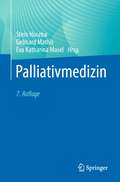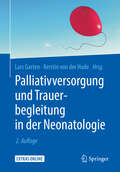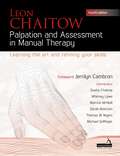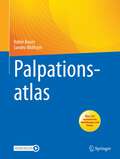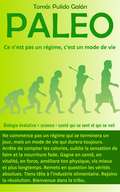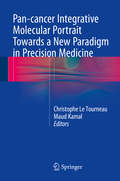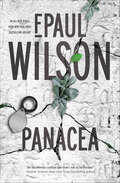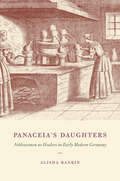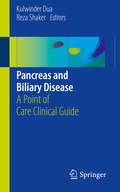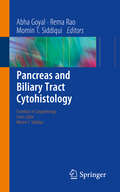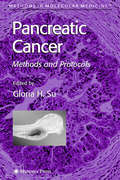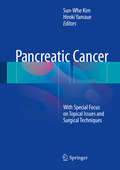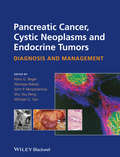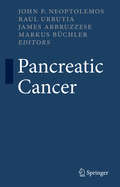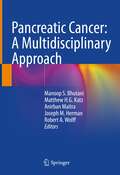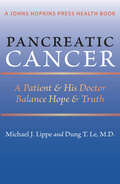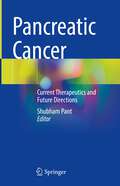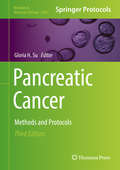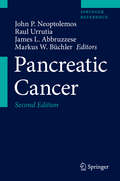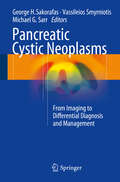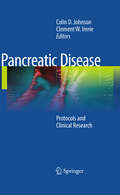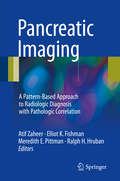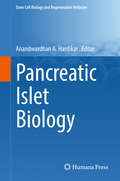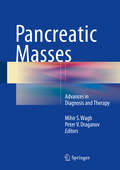- Table View
- List View
Palliativmedizin
by Gebhard Mathis Stein Husebø Eva Katharina MaselDas Buch bietet Praxiswissen für die optimale Palliativversorgung schwer kranker und sterbender Menschen. Es richtet es sich an alle, die sich professionell oder ehrenamtlich um die Begleitung Sterbender kümmern: Ärztinnen und Ärzte, Pflegefachkräfte, Tätige in der Seelsorge, Physiotherapie u.a. Aus einem reichen Erfahrungsschatz schöpfend und in klaren, einfühlsamen Worten gehen die Autoren auf alle zentralen Themen ein: Ethisch-rechtliche Grundlagen, aktive und passive Sterbehilfe, assistierter Suizid, Kommunikation mit Patienten und Angehörigen, Schmerztherapie, Symptomkontrolle, palliative Versorgung von Krebserkrankten und Nicht-Krebserkrankten, Palliativmedizin im Pflegeheim und bei Kindern. Zahlreiche Fallbeispiele helfen, die Vielschichtigkeit der Palliativmedizin zu verstehen. Die 7. Auflage erscheint komplett aktualisiert und um das Thema Spiritualität erweitert.
Palliativversorgung und Trauerbegleitung in der Neonatologie
by Lars Garten Kerstin von der HudeDieses Buch stellt die Grundlagen neonatologischer Palliativversorgung als multiprofessionelle Aufgabe dar und bietet Basiswissen und praktische Ansätze zur Trauerbegleitung früh verwaister Eltern. Von diesem Leitfaden profitieren Neonatologen, Pflegende, Psychologen, Hebammen, Seelsorger und alle anderen, die innerhalb und außerhalb der Klinik in die Betreuung und Begleitung der Familien involviert sind.In deutschen Kinderkliniken versterben jährlich etwa 1500 Neugeborene. Betroffen sind beispielsweise extrem kleine Frühgeborene, Neugeborene mit einer konnatalen Erkrankung mit infauster Prognose oder Kinder mit postnatal nicht beherrschbarer Akuterkrankung. Sterbe- und Trauerbegleitung kommt hier zum Tragen - eine der größten Herausforderungen in der ärztlichen und pflegerischen Tätigkeit. Sie umfasst nicht nur das sterbende Kind, sondern die gesamte Familie.Das Buch befasst sich unter anderem mit ethischer Entscheidungskultur, Schmerzkontrolle und der Folgebegleitung der Mutter. Die Autoren stellen Trauerkonzepte vor und geben Empfehlungen für die Selbstsorge des Teams, die Organisation und die Qualitätssicherung. Die zweite Auflage erscheint grundlegend aktualisiert und wurde um ein neues Kapitel zu perinatalen Palliativberatung ergänzt.
Palpation and Assessment in Manual Therapy: Learning the art and refining your skills
by Leon ChaitowAs the title suggests. this book has been written to assist manual therapists to understand and hone the palpatory skills which are essential to their effectiveness as practitioners. Skilful palpation is the foundation stone of all effective manual therapy assessments and treatments. The ability to use subtle and sensitive touch to examine and assess patients is essential for an accurate interpretation of the underlying problems of fascial and muscle function. The accurate interpretation of palpatory findings is difficult and comes with experience. This book aims to increase awareness of how to palpate and understanding of what is being felt.In this fourth edition of his now well-established and much loved book Leon Chaitow has introduced references to the latest research findings relating to fascia and its role in health and disease, so that practitioners can apply this knowledge in interpreting what they palpate. In addition to the author, six notable contributors from Europe and North America enhance the work's range and authority.All manual therapists, whatever their professional background, will benefit from the wealth of experience- and research-based information presented in this book.
Palpationsatlas
by Robin Bauer Sandro WolframDieser Atlas mit über 250 Abbildungen und Videos stellt ein modernes Grundlagenwerk zur Palpation für Physiotherapeuten dar: Alle wesentlichen Strukturen des Körpers werden in dreidimensionaler Perspektive dargestellt, so dass ein grundlegendes Verständnis für Zusammenhänge und Bewegungsmuster vermittelt wird. Die Palpationsgriffe sind verständlich erklärt und nachvollziehbar beschrieben. So erhalten Sie Antworten auf Fragen wie: Mit welchem Griff lässt sich der femorotibiale Gelenkspalt am besten palpieren? Welche Tastqualitäten ermöglichen die Differenzierung von Muskel und Sehne? Was muss bei der Palpation von peripheren Nerven beachtet werden? Aus dem Inhalt · Grundlagen der Palpation · Knochen, Muskulatur, Bänder, Nerven, Gefäße und Gelenke · Obere Extremität, untere Extremität, Rumpf und Kopf Auszubildende und Studierende finden hier eine optimale Einführung für die professionelle Palpation; für bereits erfahrene Physiotherapeutinnen und Physiotherapeuten ist es ein ideales Nachschlagewerk für knifflige Fragestellungen. Plus: Über 250 anatomische Abbildungen und Videos veranschaulichen Strukturen und Untersuchungsabläufe optimal.
Paléo: Biologie évolutive + science = santé qui se sent et qui se voit
by Tomas Pulido GalanNe commence pas un régime qui se terminera un jour, mais un mode de vie qui durera toujours. Arrête de compter les calorías, oublie la sensation de faim et la nourriture fade. Gagne en santé, en vitalité, en force, améliore ton physique, vis mieux et plus longtemps. Remets en question les vérités absolues. Tiens tête à l'industrie alimentaire. Vuelve a la révolution. Bienvenue dans la tribu.
Pan-cancer Integrative Molecular Portrait Towards a New Paradigm in Precision Medicine
by Christophe Le Tourneau Maud KamalThis original book provides readers with an overview of the latest developments in personalized medicine clinical trials in oncology. The topics covered range from the rationale behind this new generation of clinical trials and the latest statistical models for high-throughput molecular techniques, bioinformatics, high-throughput screening molecular techniques and the challenges entailed by implementing them in daily practice. It also covers the key role of pathology in the validation of molecular results and the complex assessment of predictive biomarkers. The different topics covered are supplemented by unique concrete examples based on the SHIVA trial. The authors are all members of the French Curie Institute, one of the world's foremost cancer research institutions.
Panacea: A Novel (The ICE Sequence #1)
by F. Paul WilsonTwo secret societies vie for control of the ultimate medical miracle in a thriller from the New York Times–bestselling author of The Hidden series.Medical examiner Laura Fanning has two charred corpses and no answers. Both bear a mysterious tattoo but exhibit no known cause of death. Their only connection to one another is a string of puzzling miracle cures. Her preliminary investigation points to a cult in the possession of the fabled panacea—the substance that can cure all ills—but that’s impossible.Laura finds herself unknowingly enmeshed in an ancient conflict between the secretive keepers of the panacea and the equally secretive and far more deadly group known only as 536, a brotherhood that fervently believes God intended for humanity to suffer, not be cured. Laura doesn’t believe in the panacea, but that doesn’t prevent the agents of 536 from trying to kill her.A reclusive, terminally ill billionaire hires Laura to research the possibility of the panacea. The billionaire’s own body guard, Rick Hayden, a mercenary who isn’t who he pretends to be, has to keep her alive as they race to find the legendary panacea before the agents of 536 can destroy it.“An excellently crafted tale that’s not to be missed.” —Heather Graham, New York Times–bestselling author“Complete with twists and turns and high adventure, this thriller will grip you to the end.” —Suspense Magazine“[A] suspenseful paranormal thriller . . . an entertaining tale, underlined by a clear battle between good and evil.” —Publishers Weekly“Complex, entertaining, smart . . . An intelligent, intriguing, fast-moving blend of science fiction and thriller.” —Kirkus Reviews
Panaceia's Daughters: Noblewomen as Healers in Early Modern Germany (Synthesis Ser.)
by Alisha Rankin"PanaceiaOCOs Daughters" provides the first book-length study of noblewomenOCOs healing activities in early modern Europe. Drawing on rich archival sources, Alisha Rankin demonstrates that numerous German noblewomen were deeply involved in making medicines and recommending them to patients, and many gained widespread fame for their remedies. Turning a common historical argument on its head, Rankin maintains that noblewomenOCOs pharmacy came to prominence not in spite of their gender but because of it. aRankin demonstrates the ways in which noblewomenOCOs pharmacy was bound up in notions of charity, class, religion, and household roles, as well as in expanding networks of knowledge and early forms of scientific experimentation. The opening chapters place noblewomenOCOs healing within the context of cultural exchange, experiential knowledge, and the widespread search for medicinal recipes in early modern Europe. Case studies of renowned healers Dorothea of Mansfeld and Anna of Saxony then demonstrate the value their pharmacy held in their respective roles as elderly widow and royal consort, while a study of the long-suffering Duchess Elisabeth of Rochlitz emphasizes the importance of experiential knowledge and medicinal remedies to the patientOCOs experience of illness.
Pancreas Transplantation – the Asian Experience: A Registry Report
by Takashi Kenmochi Duck-Jong Han Yi-Ming ShyrThis book is the first to provide a thorough overview of the experience of pancreas transplantation in Asian countries, including in particular Korea, Taiwan, and Japan. Recent trends are identified and attention drawn to differences in comparison with the United States and Europe. Such differences relate, for example, to the history of pancreas transplantation, the operative procedure, and the organ-sharing system. In addition, the insulin-secreting ability of pancreatic islet cells is thought to vary depending on race. Beyond these aspects, the coverage also encompasses ABO-incompatible living donor pancreas transplantation, which is very rarely performed elsewhere in the world. By introducing the number, technique, and outcomes of pancreas transplantation in Asian countries, the book will hopefully further stimulate the pancreas transplantation program in this region and beyond. It will be of value for all medical professionals in the field and will be informative for diabetic patients receiving insulin treatment in Asia.
Pancreas and Biliary Disease
by Reza Shaker Kulwinder DuaThis handbook provides a comprehensive overview of common disorders affecting the pancreas and the bile duct. The book reviews the anatomy and laboratory test relevant to the pathophysiology of the disease, categorizes the symptoms under clinical scenarios like "incidental finding" or "painless jaundice", defines accuracy (or lack of) of the investigations used, and formulates a management plan as per evidence-based recommendations. The spectrum of diseases covered include commonly occurring benign conditions like pancreatitis, gall stone disease, bile duct strictures, and malignant diseases of the pancreas, gall bladder and the bile ducts. Also included are topics on motility disorders of the pancreaticobiliary system and pre-malignant conditions. Written by experts in the field, Pancreas and Biliary Diseases: A Point of Care Clinical Guide is a valuable reference resource for clinicians who need the latest evidence-based approach to manage these complex patients and answer questions the patient or the referring doctors may have regarding pancreas and biliary diseases.
Pancreas and Biliary Tract Cytohistology (Essentials in Cytopathology #28)
by Momin T. Siddiqui Rema Rao Abha GoyalThis book focuses on all aspects of pancreatic pathology, from key features of benign and malignant lesions to diagnostic pearls for differential diagnosis of encountered entities in pancreatobiliary fine needle aspirations and small biopsies. Chapters include a brief introduction and a practical approach to diagnose benign and malignant lesions. The key cytomorphologic features and main differential diagnoses are also summarized in concise tables. Richly colored images complement the text and represent key findings pertaining to the text discussion. An important and current chapter on molecular testing proves to be very useful for the readership for their daily practice in this era of targeted therapy. Written by experts in the fields, all authors contribute their collective experience of preeminent cytopathology service spanning a long time span. Pancreas and Biliary Tract Cytohistology serves as a practical resource for cytotechnologists, cytopathologists and pathologists who are practicing cytopathology and rendering diagnoses on small biopsy samples on pancreatic lesions.
Pancreatic Cancer
by Gloria H. SuThis ambitious collection of essential yet novel methods for pancreatic cancer research or cancer research in general features an outstanding cast of authors who are esteemed leaders in the field. The authors provide a broad range of methods for molecular, biochemical, pathological, and statistical analysis of sporadic and familial pancreatic cancer, methods that can be applied not only to basic, but also to translational pancreatic research. Topics covered include in vitro cell cultures, in vivo mouse models, protein studies, mutation analysis, and treatment development.
Pancreatic Cancer
by Sun-Whe Kim Hiroki YamaueThis book provides state of the art knowledge on a broad range of clinical issues in pancreatic cancer, covering topics from screening and pathophysiology to surgical treatments. In particular, the focus is on current controversies and on evidence-based surgical techniques. Further aspects considered include the management of precancerous lesions, diagnostic methods, perioperative care and nonsurgical treatment. The description of surgical methods is supported by many helpful illustrations and important technical issues are carefully addressed. Determination of resectability and extent of surgery is also discussed. Based on recent developments in surgical techniques, some surgeons are performing more and more radical operations. It is essential, however, that surgical strategy is based on the best available evidence and surgeons will find that this book offers valuable help in achieving this aim. In addition, it will be a great asset in clinical practice for all who are involved or interested in the management of pancreatic cancer.
Pancreatic Cancer, Cystic Neoplasms and Endocrine Tumors
by John P. Neoptolemos Michael G. Sarr Shu You Peng Hans G. Beger Akimasa NakaoPancreatic Cancer, Cystic Neoplasms and Endocrine Tumors: Diagnosis and Management is a modern, expertly crafted and clinically focused guide to the diagnosis, management and best-practice care of patients suffering from pancreatic cancer, cystic neoplasms and endocrine tumours. Packed with outstanding figures and with reference to the leading society guidelines, its main focus is on the many endoscopic and radiologic diagnostic techniques, medical and surgical management of both full-blown cancer and other tumors, and the risks of each form of treatment. Also covered in detail are issues of tumor recurrence and long-term outcome of treatment. Brought to you by highly skilled national and international leaders in the specialty and an experienced editor team, this is an invaluable guide to practicing gastroenterologists and surgeons in the hospital and clinical environment, as well as oncologists and endocrinologists managing patients with pancreatic tumorous lesions.
Pancreatic Cancer, Volume 1
by John P. Neoptolemos Markus W. Büchler Raul A. Urrutia James AbbruzzeseWorldwide, there are an estimated 232, 000 new cases of pancreatic cancer annually. In the United States, it is the fourth leading cause of cancer death, and approximately 30,000 people die of pancreatic cancer each year. The disease is difficult to diagnose in its early stages, and most patients have incurable disease by the time they present with symptoms. The overall 5-year survival rate for this disease is less than 5%.<P><P> In organizing this handbook, Dr. Neoptolemos and his co-editors will produce a distinguished Major Reference Work devoted to pancreatic cancer. This handbook will have widespread appeal among clinicians, pathologists and basic scientists who are now struggling to understand this complex and rapidly expanding field.<P> Because of the recent and vast growth in both the clinical and scientific research being done in pancreatic cancer (there is currently an unprecedented investment by academia and industry in this field), each researcher’s knowledge of other specialty areas outside his or her own is now often quite limited. The aim of this book is to place these the tangible advances—those that are indispensable to all working on pancreatic cancer—readily at hand. The book will focus on advances that will not become dated, and the editors will choose authors who are the very best in each area.
Pancreatic Cancer: A Multidisciplinary Approach
by Anirban Maitra Joseph M. Herman Manoop S. Bhutani Matthew H. G. Katz Robert A. WolffThis book provides a comprehensive, state-of-the-art overview of pancreatic cancer. The text presents new data about risk factors and genetic predisposition for pancreatic cancer, highlights current screening strategies and preliminary results, and reviews diagnosis and staging of pancreatic cancer, with a focus on imaging evaluations, laparoscopy, endoscopic ultrasound-guided biopsies, and biomarkers. The book also spotlights emerging paradigms in pancreatic cancer management, such as minimally invasive surgical approaches and emerging radiation approaches, and provides valuable insight into the role of nutrition and early integration of supportive/palliative care for pancreatic cancer patients. Written by experts in the field, Pancreatic Cancer: A Multidisciplinary Approach is an invaluable resource for physicians and researchers with an interest in pancreatic cancer.
Pancreatic Cancer: A Patient and His Doctor Balance Hope and Truth (A Johns Hopkins Press Health Book)
by Michael J. Lippe Dung T. LeMichael J. Lippe was diagnosed with pancreatic cancer in 2007. This is his story, and the story of pancreatic cancer, narrated by Lippe and Dr. Dung T. Le, the physician who is treating him.In telling these stories, Lippe and Le alternate chapters. Lippe writes about the early signs that something was wrong; Le continues with a description of pancreatic cancer, its symptoms, and its treatments. Lippe talks about his prognosis, contemplates the prospect of death, and describes how he began to cope; Le explains the importance, for both doctor and patient, of balancing hope and truth. Lippe speaks frankly about the toll the disease takes on his marriage and family; Le offers a general picture of what most patients can expect with their illness. The book concludes with Lippe and Le’s reflections on their partnership in treating cancer, lessons they have learned, and their thoughts about the positive things that sometimes emerge from illness.Pancreatic Cancer offers clear explanations of what the disease is, describes what people with the disease will feel physically and mentally, and discusses current treatments and future directions of research. The authors hope that their honest yet hopeful perspective will help all people with cancer and those who care about them.
Pancreatic Cancer: Current Therapeutics and Future Directions
by Shubham PantPancreatic cancer is a challenging and complex disease characterized by a dense fibrotic stroma and an immunosuppressive tumor microenvironment. Until recently, there were no predictive biomarkers to personalize selection of targeted or biologic therapies as a part of standard of care treatment. Moreover, the regulatory immune population of cells creates a “cold”, non-immunogenic tumor that is resistant to immunotherapies including checkpoint inhibitors. However, in the last few years, there has been substantial progress in our understanding of the role mutations in the pathogenesis of disease leading to increased adoption of germline and next generation sequencing to identify mutations and fusions to optimize selection of therapies and select patients for clinical trials of targeted agents.This book provides a comprehensive, global overview on therapy for pancreatic cancer, exploring approved therapies and focusing on the “Next” in drug development including molecularly targeted therapy and efforts at “Drugging the Undruggable”: the KRAS mutation. It also addresses efforts at targeting the inhospitable stroma to improve drug delivery to the tumor cells, incorporating ct DNA (liquid biopsies) in the care of patients and recent advances in immunotherapy. Pancreatic Cancer: Current Therapeutics and Future Directions will illuminate these challenges, review existing therapeutics, and highlight current and future efforts to improve outcomes in this devastating disease. Useful to physicians, fellows, medical students, residents, physician assistants, nurse practitioners, pharmaceutical companies and researchers interested in pancreatic cancer, it will first explain management of localized disease including resectability and adjuvant and neoadjuvant therapies. Targeted therapies including molecular, immunotherapy, stroma and role of ctDNA or “liquid biopsies” will be addressed. Finally, the book will explore the important role of pain management, diet and exercise in improving outcomes in pancreatic cancer.
Pancreatic Cancer: Methods and Protocols (Methods in Molecular Biology #1882)
by Gloria H. SuThis third edition volume expands on the previous editions with discussions on the latest developments in 2D- and 3D-organoid cultures that allow for the execution of precision medicine, and in vitro studies of tumor cell growth and invasion. The chapters in this book explore protocols for evaluating macropinocytosis, stress granules, autophagy, metabolic alterations, and reactive oxygen species, which have proven to be possible therapeutic opportunities. The protocols described in this book look at both human and animal models, ranging from in vitro and in vivo, and will aid in future research of pancreatic cancer. Written in the highly successful Methods in Molecular Biology series format, chapters include introductions to their respective topics, lists of the necessary materials and reagents, step-by-step, readily reproducible laboratory protocols, and tips on troubleshooting and avoiding known pitfalls.Cutting-edge and comprehensive, Pancreatic Cancer: Methods and Protocols, Third Edition is a valuable resource for scientists and researchers who are interested in learning more about ways of improving patient care for pancreatic cancer.
Pancreatic Cancer: What You Need To Know
by John P. Neoptolemos Markus W. Büchler Raul Urrutia James L. AbbruzzeseIn organizing the second edition of this renowned Handbook, Dr. Neoptolemos and his co-editors have produced and updated a revised edition to the distinguished Major Reference Work devoted to pancreatic cancer. Like its preceding edition, the second edition continues to have a widespread appeal among clinicians, pathologists and basic scientists, who are now struggling to understand this complex and rapidly expanding field. Because of the recent and vast growth in both the clinical and scientific research being done in pancreatic cancer, (there is currently an unprecedented investment by academia and industry in this field), each research’s knowledge of other specialty areas outside his or her own is often quite limited. The aim of the new edition is to place the tangible advances, including new developments in surgical approaches with regards to resection techniques, the state of laparoscopic approaches, the growing impact of surgical approaches in the management of recurrent pancreatic cancer, controversies in the management of IMPN as the precursor lesion for PDAC and others – readily at hand. The second edition focuses on advances that will not become dated, and the editors have chosen authors, who are the very best in each area.
Pancreatic Cystic Neoplasms
by Michael G. Sarr George H. Sakorafas Vassileios SmyrniotisThis book provides a thorough overview of the detection of PCNs using modern imaging techniques and a clear guide to the recognition of the different subtypes of PCN based on their radiologic and histopathologic features. This volume will serve as an excellent aid to the selection of optimal therapeutic strategies based on preoperative diagnosis. A further important feature is the emphasis placed on radiologic, clinical, and surgical correlations. Pancreatic cystic neoplasms (PCNs) have been increasingly recognized during the past decade, mainly because of the widespread use of modern imaging modalities for the investigation of often unrelated abdominal symptoms. The three most common subtypes of PCN are serous cystic neoplasms, mucinous cystic neoplasms, and intraductal papillary mucinous neoplasms. These subtypes have distinct radiologic and histopathological features, and their biological behavior differs greatly. Accurate preoperative diagnosis is of prime importance in selecting the optimal therapeutic strategy: while serous cystic neoplasms are almost always benign, and may be treated conservatively, mucinous cystic neoplasms and intraductal papillary mucinous neoplasms have malignant potential, warranting an aggressive surgical approach, i. e. , pancreatectomy. Pancreatic Cystic Neoplasms will be of great interest to surgeons, gastroenterologists, radiologists, oncologists, and pathologists, and also to internists and residents in these specialties.
Pancreatic Disease
by Colin D. Johnson Clement W. ImrieThis book will contain the conclusions of a meeting from March 2007, of about 25 experts in pancreatology working together in small groups and plenary sessions to define the current state of knowledge in specific areas, and to develop ideal protocols and research questions for future investigation.
Pancreatic Imaging
by Elliot K. Fishman Atif Zaheer Meredith E. Pittman Ralph H. HrubanThis comprehensive teaching atlas covers virtually all pancreatic anatomy (including variants) and diseases in a pattern-based radiologic approach. Cases are presented as "unknowns", allowing the reader to analyze the findings and learn key points. Each teaching case includes a brief clinical history, images, a description of imaging findings, differential diagnoses, final diagnosis with images of gross pathology, and a discussion of key teaching points. The presented images have been acquired with the full range of relevant modalities, including state of the art technologies such as multidetector row dual-phase CT, 3D reformatting, and multiple MRI sequences. The book will help radiologists, radiology residents and fellows to sharpen their diagnostic skills by looking at a vast array of pathology from a major tertiary hospital (Johns Hopkins) and will also assist in preparation for radiology board examinations.
Pancreatic Islet Biology
by Anandwardhan A. HardikarThis comprehensive volume discusses in vitro laboratory development of insulin-producing cells. It encompasses multiple aspects of islet biology--from embryonic development and stem cell differentiation to clinical studies in islet transplantation, regulation of islet beta-cell regeneration, pancreatic progenitors, mathematical modelling of islet development, epigenetic regulation, and much more. The chapter authors represent leading laboratories from around the world who contribute their international perspectives and global expertise. Collectively, they provide the reader with a concise yet detailed knowledge of processes and current developments in islet regenerative biology. Pancreatic Islet Biology, part of the Stem Cell Biology and Regenerative Medicine series, is essential reading for researchers and clinicians in stem cells or endocrinology, especially those focusing on diabetes.
Pancreatic Masses
by Mihir S. Wagh Peter V. DraganovThis volume provides a comprehensive, state-of-the art review of the management of pancreatic lesions. The book reviews the differential diagnosis and pathology of different pancreatic lesions, profiles new advances in endoscopic evaluation, highlights new perspectives about imaging modalities, describes current treatment strategies and provides an algorithmic approach to management of pancreatic tumors. Recently published literature is placed in context with current management recommendations. The text also discusses the latest advances in minimally invasive techniques, such as Endoscopic Retrograde Cholangio-Pancreatography (ERCP) and Endoscopic Ultrasound (EUS). Written by experts in their fields, Pancreatic Masses: Advances in Diagnosis and Therapy is a valuable resource for gastroenterologists, surgeons and internists that helps guide patient management and stimulate investigative efforts.
